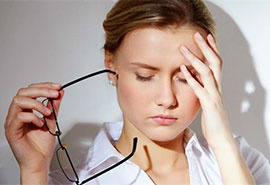
Vertigo is actually a symptom that is quite common. It can also be defined as an illusion of movement that does not actually exist. For example, a person who has vertigo in a room has the feeling that the surrounding walls are spinning around him or that he is spinning around himself. 'Vertigo' is actually a word that comes from the Latin verb 'vertere’ which means ‘to turn'. What is essential is to determine the cause of vertigo.
We maintain our balance through a very complex mechanism. In this complex mechanism, the inner ear, the eye, the proprioceptive senses originating from the tendons, the cerebellum and the brain play a role. A problem in any part of this complex mechanism may present as dizziness.
Depending on the underlying disease, dizziness may be in the field of interest of ENT, Neurology, Neurosurgery and Internal Medicine disciplines.
The three most common causes of vertigo concerning ENT are BPPV(Benign Paroxysmal Positional Vertigo), Meniere's and Vestibular Neuritis.
The two main functions of the ear are hearing and balance. Sound energy, which passes through the external ear canal and vibrates the eardrum, makes the malleus, incu, and stapes ossicles vibrate. The stapes is an ossicle in connection with the inner ear, and the energy in question is converted in the cochlea in the inner ear and transferred to the central nervous system by the cochlear nerve. This is how we can hear. In the ‘labyrinth’ , fluids called perilymph rich in sodium and endolymph rich in potassium circulate in the inner ear without mixing with each other under normal conditions. The role of the inner ear in the balance function is to provide data related to horizontal, vertical and angular movements detected by anatomical structures such as utricle, saccule and semicircular canals, and to transmit this data to the central nervous system by the vestibular nerve.
Benign Paroxysmal Positional VertigoBPPV is the most common cause of dizziness related to the ENT.
Normally, we all have tiny crystals in our ears called ‘otoconia’. While these otoconia are located in the structures called the utricle and saccule, they are not present in the semicircular canals. If these otoconia somehow escape into the semicircular canals, the patient will have vertigo. Typically, the vertigo occurs when turning left or right in bed, trying to get something off the shelf in the kitchen, or walking down the stairs. The vertigo lasts seconds, it can be very severe, and can be accompanied by nausea and vomiting. The patient feels generally dizzy afterwards. There is no hearing loss or ringing in the ears. The known causes of BPPV include head trauma, prolonged bed rest, and some previous ear surgeries. It has also been reported that the frequency of BPPV increases after vestibular neuritis. However, in most of the patients’ past, the reasons mentioned above are not encountered.
History is very important in the diagnosis of BPPV. When this disease is suspected, the diagnosis is made with a manoeuver called the 'Dix-Hallpike' manoeuver, and ‘Roll’ manoeuver for lateral semisircular canal. Once the diagnosis is made, the treatment is achieved via canalolith reposition manoeuvers (CRMs) such as Epley, or BBQ. The effectiveness of even a single CRM is very high. If the disease recurs, over 95% success has been reported with 3 maneuvers. Drug therapy has no role in the treatment of crystal shift. Rarely, if the patient experiences excessive nausea and vomiting during diagnosis-treatment maneuvers, anti-nausea drugs can be used.
Meniere's DiseaseMeniere's Disease, described by French Prosper Meniere, is a disease that occurs in attacks, presenting with ringing in the ear, a sensation of fullness, ringing, hearing loss and vertigo. These symptoms can last from 20 minutes to 24 hours. The patient may experience nausea and vomiting during the attack. Hearing loss is temporary in the first attacks, typically includes low frequencies, and hearing returns to normal after the attack. However, as the number of attacks increases, permanent hearing loss can be seen. Meniere can be bilateral in approximately one third of patients.
The diagnosis is made with history, hearing and balance tests. Treatment can be evaluated in two ways: attack treatment and preventive treatment. In the treatment of attacks, if the patient has nausea and vomiting, he or she should be hospitalized and intravenous diazepam and diphenhydramine treatments can be given. Once the attack is resolved, preventive treatments are administered. The first step in treatment is lifestyle changes. The patient is advised to consume less salt, to quit smoking if he smokes, not to take alcohol, especially fermented ones such as wine and beer, and to stay away from stress. Betahistine is the most commonly used agent in drug therapy. Diuretic drugs called acetazolamide can also be used. If the attacks cannot be controlled despite these treatments, intatympanic injections of cortisone or gentamicin are considered.
Surgical treatments can be applied in patients who do not benefit from drug treatments. They include endolymphatic sac surgery, vestibular neurectomy, which are preserving the hearing; and labyrinthectomy, which consists of ablation of hearing and balance function of the affected ear. As a result, the aim of Meniere's treatment is to keep the disease under control with lifestyle changes and drug treatments. Very few patients require surgical treatment.
Vestibular NeuritisIt is an inflammation of the balance nerve. Viruses are responsible. The patient may have had a viral upper respiratory tract infection 1 week to 10 days ago. Symptoms include sudden onset of severe nausea, vomiting, and vertigo. If the symptoms are severe, the patient is hospitalized, and intravenous drugs such as diazepam and diphenhydramine are given to relieve the symptoms. Afterwards, the therapy is continued with pills. Symptoms can last days. In typical disease, the patient's hearing is not affected. It may be necessary to confirm that there is no central pathology with a neurology consultation.


